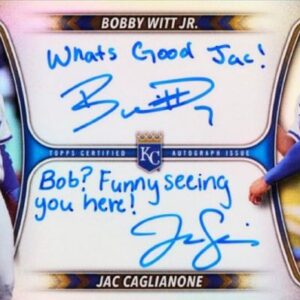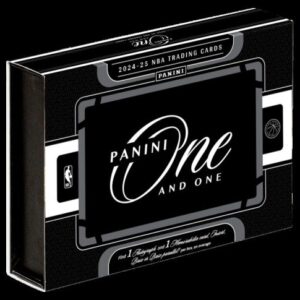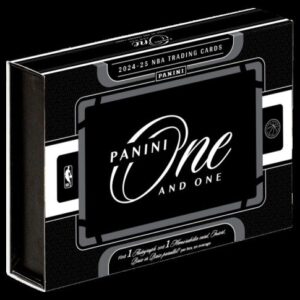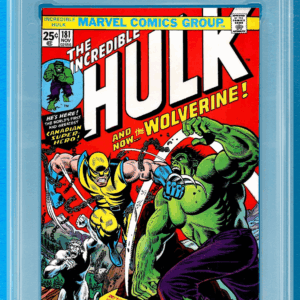In a world where long-gone players’ autographs grace relics of dusty card collections, Kansas City baseball’s dynamic duo, Bobby Witt Jr. and Jac Caglianone, are flipping the script in the most delightful way possible. No longer are cards just about a player’s name and stats; now they boast inscriptions filled with wit, jokes, and friendly banter, infusing the timeless hobby with a fresh and comedic flair. These two players have taken their talents off the field and onto the beloved baseball card, giving fans a slice of their personalities and friendship, setting an entertaining precedent for future memorabilia.
Imagine holding a card where instead of just a routine autograph, you are greeted with Witt’s and Caglianone’s personal exchanges. Talk about adding more value than the typical collector’s grade! Among the bonanza of humor are Caglianone’s cheeky comments to Witt, like, “If I pull your card, you owe me this one,” a reminder to collectors that there’s a collector’s camaraderie beyond the sharpie ink. This banter harks back to elementary school trades but with a whimsical twist that’s utterly charming for the initiated.
Witt, never one to be left out of a playful jab, flips the narrative, asking Caglianone for his “workout plan.” It’s a testament to the fun rivalry that thrives on the field and beyond. Witt—a baseball card lover himself—appreciates the brawn and size difference: he’s five inches and 50 pounds shy of matching Caglianone’s physical presence. It’s this kind of humor that humanizes the stars, making them relatable to fans who covet their cards as much as their feats on the baseball diamond.
The players’ Superfractor cards, which are virtually the Holy Grail for card collectors due to their rarity and distinct shine, are not exempt from this personal touch. They serve as a medium not just for congratulations on professional achievements but also for personal milestones. Witt’s nod to tying the knot and Caglianone’s journey toward popping the question is heartwarming. Their exchanges turn the tangible card into a time capsule, intertwining personal circles with professional accomplishments, making them cherished mementos with stories far beyond the game statistics.
This evolution of baseball cards represents a broader culture shift where more current athletes are embracing their inner card-collecting kid. It’s about connecting with their past or perhaps preserving their own history in the making. Caglianone is unapologetic in his enthusiasm, even pausing during an apartment search to succumb to the lure of a card buy. He even scrawls “My 1st Bowman auto” on his inaugural card, ensuring that milestone is forever marked and celebrated.
Equally invested in this narrative art form is Witt, whose relationship with cards is the stuff of legend—or at least a dinner table story. Using customized baseball cards as his wedding invites, Witt blends tradition with personal style, honoring the hobby while creating unique keepsakes for his guests. His stealthy auction bidding under a pseudonym signals a deeper engagement with the collectible economy and a willingness to covertly secure pieces of his journey. Every home run brings him back to his cards, literally, as he purchases one of his rookie cards for every ball that clears the park.
This playful injection into the solemn world of sports memorabilia isn’t just about shenanigans; it breathes fun back into collecting—a dedication to ensuring the hobby remains lively and approachable even as it intermingles with cherished memories across the fan base. As fans clutch at their signed cards, these inscriptions encourage more interaction, provide narrative depth, and prompt debates about who among today’s players will next follow in Witt and Caglianone’s footsteps.
The dialogue created simply by scratching thoughts on cardboard reverberates, bridging fans, collectors, and the athletes themselves in a shared experience. Would anyone object to a league full of athletes who entertain us far beyond the confines of the field? Fans and collectors alike can share in the hunters’ thrill—not just for their rarity and potential value but for the stories new cards tell and the moments they capture.
One thing’s for sure: Witt and Caglianone have changed the game, turning what was once merely a token of fandom into a living, breathing canvas of personality and camaraderie. As these two new-wave players continue to litter their cards with innuendo and anecdotes, the impact of their signatures might just herald a joyful rebellion in sports memorabilia that fans didn’t even know they needed. Onward with the inscriptions, because with every witty remark, baseball cards become not just collectibles, but conversation starters that everyone can enjoy.






